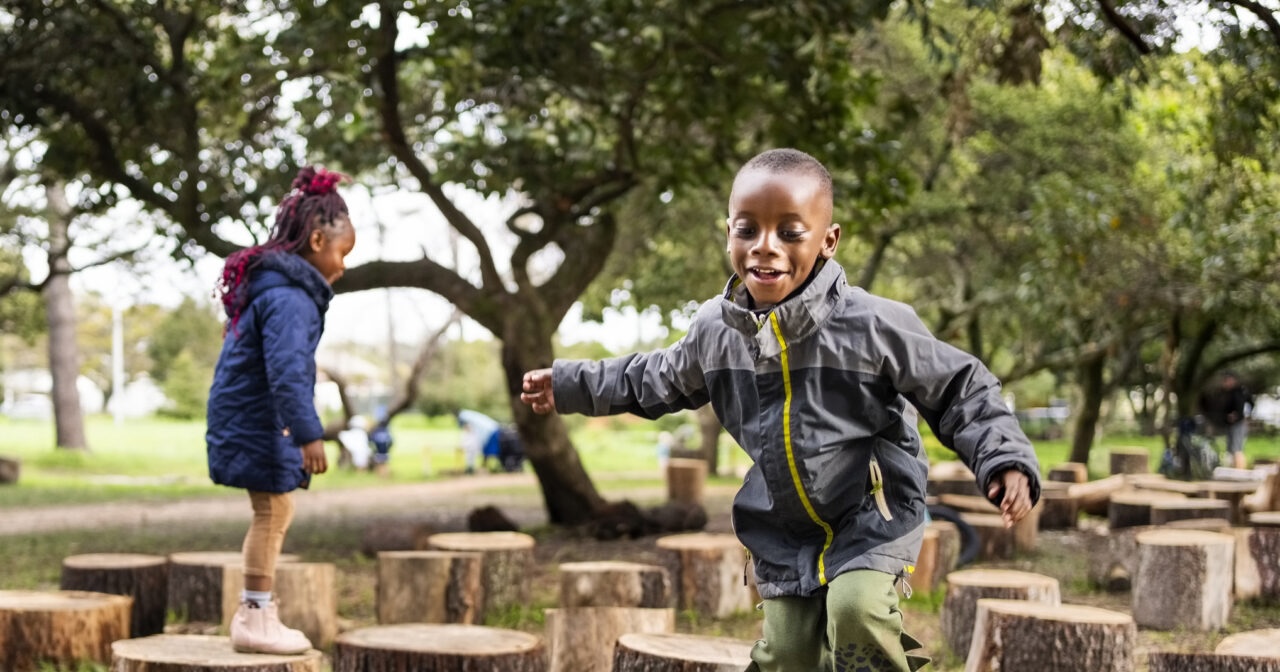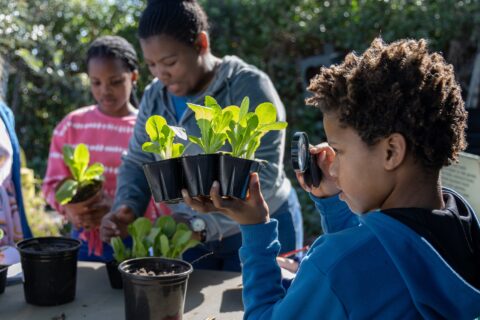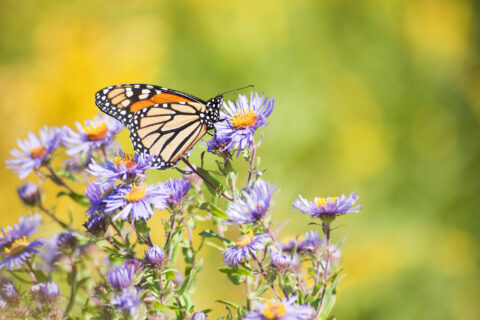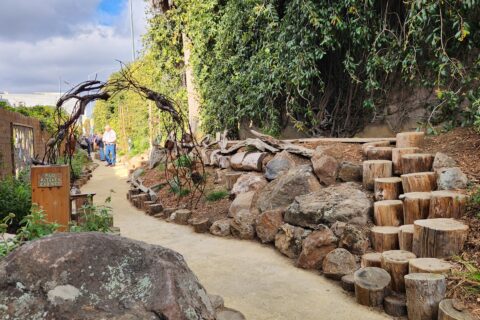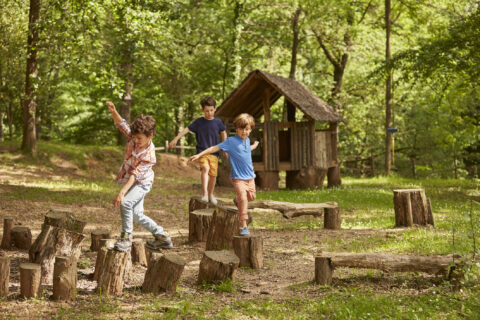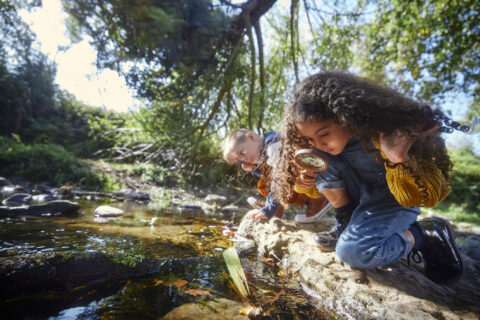Every day, city leaders face two interconnected challenges: preparing communities for a changing climate, and creating healthy environments where children can thrive through frequent connections to nature. The good news is that strategies that make cities more resilient to challenges such as extreme heat, flooding and poor air quality can also strengthen childhood development, improve community health and make kids healthier, happier and smarter.
Across the country, cities, towns and villages are rethinking how they design, fund and maintain public spaces. A growing number of communities view schoolyards, libraries, parks and early learning centers– places where children spend a lot of time — not as separate assets, but as part of an integrated climate resilience strategy. When cities weave climate strategies into these community touchpoints, they deliver measurable environmental gains while advancing access to nature for every child. Read on for examples and to learn about a new resource for cities.
Why Nature Belongs in Every City’s Climate Strategy
Cities are increasingly turning to nature-based solutions and green infrastructure strategies that use natural systems to solve urban challenges. Trees, rain gardens, green roofs and permeable surfaces capture and filter stormwater, reduce heat and clean the air. Places where children spend time, these solutions and strategies also create vibrant places for children to play, learn and grow, strengthening both physical and social-emotional health. Embedding nature into daily life also builds climate literacy and a sense of stewardship from the earliest ages. Children who explore nature close to home develop curiosity and confidence, traits that prepare them to navigate complex futures shaped by climate change.
When cities combine resilience planning with investments in green spaces for children, they’re not just preparing for the next storm; they’re building the next generation of problem solvers and environmental stewards.
Four City Approaches to Building Nature-Rich Resilience
1. Climate Resilience and Nature in Early Childhood
Cities can strengthen climate resilience and early learning simultaneously by incorporating natural features, trees, water, soil and shade into early childhood environments.
In Denver, Colorado, Denver’s Parks and Recreation Department (DPR), in collaboration with partners, community members and other city departments, has been driving the creation of early childhood nature connection policies, initiatives and sites across the city. The Parks and Recreation Department’s Game Plan for a Healthy City ensures every resident lives within a 10-minute walk of a park. The city also worked with the Mile High Flood Protection District to streamline permitting for nature play spaces that also manage stormwater. These dual-purpose landscapes encourage exploration and motor development while improving water quality and reducing flood risk in nearby neighborhoods.
2. Green Schoolyards are Climate Resilience Strategies
Schools are natural partners in connecting children to nature and increasing municipal resilience. Reimagining paved or grassy schoolyards as green, shaded community assets reduces heat and expands access to safe outdoor learning spaces while also helping to address stormwater management and other climate-related issues.
In Milwaukee, Wisconsin, the nonprofit Reflo collaborates with Milwaukee Public Schools and the Metropolitan Sewerage District to convert asphalt-heavy schoolyards into multifunctional green spaces. Native plantings and interactive water features manage stormwater while giving students hands-on lessons in ecology and engineering. These schoolyards cool surrounding blocks, support pollinators and serve as models for climate-ready design.
3. Nature-Smart Libraries and Climate Resilience
Libraries are often overlooked climate assets. As trusted public spaces, which children often frequent, within walking distance for most residents, they can anchor neighborhood-level resilience.
The Austin Public Library system launched its Nature-Smart Libraries initiative to align with the city’s climate action plan. At the LEED Platinum-certified Central Library, children can read under native trees in a rooftop garden equipped with solar panels and stormwater features. Across the city, library branches host StoryWalks®, nature-themed programs and shaded outdoor play areas, bringing together learning, climate adaptation and community connection.
4. Nature Exploration Areas and Climate Resilience
When small urban parcels or parks and playgrounds in need of updating are re-envisioned as nature exploration areas, cities can add green infrastructure and expand equitable nature access at the same time.
In Providence, Rhode Island, the city and its partners have renovated nearly all public parks to include natural play areas, native meadows and outdoor classrooms. These spaces reduce maintenance costs, increase biodiversity and help manage stormwater while offering residents nearby opportunities to connect with nature. Providence’s approach demonstrates how equity and environment can reinforce each other, especially in historically disinvested neighborhoods.
An Online Toolkit for Cities
To help cities put these ideas into practice, Nature Everywhere Communities, a partnership between the National League of Cities, the Children & Nature Network and KABOOM!, developed the Climate Resilience and Children’s Nature Connection Toolkit, an online guide for embedding climate resilience into places where children live, learn and play.
The toolkit offers:
- A deeper look into how climate resilience strategies can integrate into early childhood, green schoolyards, nature-smart libraries and nature exploration areas.
- Community examples, case studies and photos showcasing how other cities have accomplished these goals.
- Guidance and resources on partnership building, community assessment and coalition building to support long-term sustainability of efforts.
The toolkit highlights solutions that cities can implement now, using existing public spaces and partnerships, to create more livable neighborhoods and a stronger sense of belonging.
Every park bench, library courtyard and school garden is an opportunity to connect local climate goals with childhood health and wellbeing. By prioritizing nature-based and green infrastructure strategies, city leaders can stretch limited dollars further, achieving environmental, educational and equity outcomes all at once. When children grow up in green, resilient spaces, they learn that their city cares about their future. That lesson might be the most powerful climate investment of all.
Learn More
Explore the Climate Resilience and Children’s Nature Connection Toolkit to see how your city can align climate action and childhood wellbeing, building resilience from the ground up.
